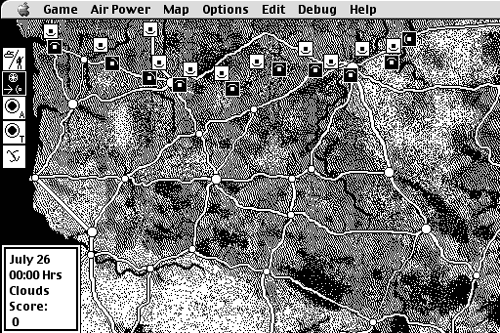To Hell with Grids
| At that time, wargame designers were wasting a lot of breath arguing over the relative merits of hexgrids and rectgrids. (See Chapter 13 "Tanktics," for an explanation of hexgrids.) The rectgrid was better suited to the computer, but traditional boardgames had always used hexgrids. Some wargame designers sneered that wargames with rectgrids were not the genuine article; real wargamers played with hexgrids. I had started off using hexgrids in my very first computer game design (Tanktics), but had shifted to rectgrids for Eastern Front (1941) and was convinced of their greater utility. However, I tired of the whole stale debate. Why should we have any grids? It seemed rather silly to have military units hopping across terrain like frogs. Shouldn't they move in a smooth series of tiny steps? That, I decided, would be the first element of my design. But this led to a problem: How do I specify the terrain at various locations? In conventional wargames, each square or hex contains some specified terrain type, which affects movement and combat. How could I have terrain if I didn't have squares or hexes into which to put it? The solution, obtained after much fretting, was ridiculously simple: "What you see is what it is." The map is the terrain (see Figure 22.1). 22.1. Patton Versus Rommel.
The idea here is simple: The darker the terrain, the denser it is and the more it impedes motion. I could get away with this because the terrain in Normandy is basically flat; the density of woods and the bocage is the only militarily significant terrain. Therefore, I showed that density by the darkness of the terrain on the map. This made terrain calculations ridiculously simple: The unit only had to count the number of black pixels in the map square underneath it. Some special calculations were required for road movement; the algorithm had to trace the roads to figure out whether a unit could gain the movement benefits of moving along a road. But this was not so great a headache. With this simple innovation, I could move the units smoothly across the map, a pixel at a time. My next innovation was to extend the concept of unit posture even further. With Eastern Front (1941), I had three modes: attack, defense, and movement. For this game, I decided upon five modes: light defense, strong defense, probing attack, major attack, and road mode. I also used eight directions of facing; these innovations made the mechanics of battle more interesting, I believe. And of course, I retained the same disruption system I had used in previous wargames; I believe that disruption systems permit more movement on the front line without ridiculously high casualties. |
EAN: 2147483647
Pages: 248
